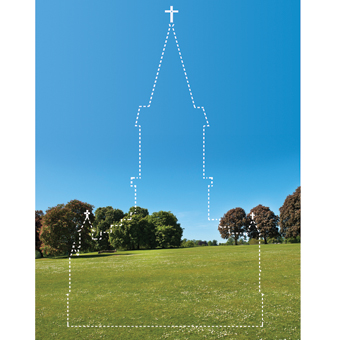Parishes building new churches struggle to find the right marriage of bricks and mortar to house the body of Christ.
On the last Sunday of every month, Father John Jamnicky gets on a scale. Within moments his weight loss is posted on a big chart in the fellowship room of his church. “At 65, I have probably lost and gained more weight than the whole parish combined!” says Jamnicky, laughing.
So far, he’s lost 36 of the 100 pounds he’s promised to shed for the “Building a Church, Pound by Pound” capital campaign for the new St. Raphael the Archangel Church in Old Mill City, Illinois. Parishioners have pledged money for every pound their pastor loses. Some have begun dieting themselves and collecting additional pledges. With that money, matched by a donor, St. Raphael’s stands to raise at least $110,000 and get healthier, too.
“Everything about the church we are building is unique,” Jamnicky says of the new structure, which will incorporate the exterior and interior of two closed churches (see sidebar, page 15). “And everything we’re doing to raise funds is unique, too.”
Despite difficult economic realities, parishes continue to undertake church building programs, whether it is to renovate and repair old buildings, build a new home for consolidated parishes, or open a new church in a growing community. And these building projects are typically the largest a parish will ever undertake.
In addition to the nuts and bolts of construction and renovation, the demands of liturgy, aesthetics, education, and funding call for multiple layers of decision-making and coordination.
Such projects rely on the clear vision of the parish and the efforts of community members who feel called to this challenging but ultimately satisfying ministry. Above all, building a new church is an occasion of grace, one that invites the entire community to renew its faith along with its place of worship.
Foundation work
A church is a community—and not just one building—composed of spaces that support assembly, worship, administration, education, and fellowship. Good design happens from the inside out, so before breaking out the tool belts, a parish has to put on its thinking cap and reflect on its ritual, devotional, and hospitality needs—and understand how these spaces relate to each other.
“My first advice is to help a community understand that this is a time of renewal for the parish, both spiritual and liturgical,” says Franciscan Father Gil Ostdiek, a professor of liturgy at the Catholic Theological Union in Chicago. “By asking themselves, ‘Who are we as a people of God? What do we do when we gather?’ the community can free itself to think more expansively.
“Of all the languages of liturgy, space is the most subtle and least attended to, and yet provides a powerful symbolic communal identity,” Ostdiek says. “Many of the spaces we have inherited are out of alignment with the shape of the rite and its performance, but people are reluctant to change [these spaces] because they are basic identity symbols.”
Guided discussions about liturgy and its architectural implications can help parishioners grasp what goes into creating sacred space. Practical conversations about the design and construction process will help the community select the right architects, liturgical designers, and contractors, as well as evaluate design schemes and budgets.
“With our pastor, Father Francis Peffley, the building committee visited 28 churches to see what we liked, what worked, what didn’t. We spoke to pastors and parish administrators, and learned from others’ experiences,” says Betty Childers, who with her husband, Kevin, headed up the capital campaign for Holy Trinity Church, a 1,200-seat church serving 3,800 families in Gainesville, Virginia. These observations shaped a requirements document that was sent to potential architects.
Typically, a parish figures out what it can realistically afford and then finds an architect who can work within its budget. “I wouldn’t distinguish between a client with a limited budget from one with a huge budget. In some ways, a limited budget encourages creativity,” says architect Craig Rafferty of Rafferty Rafferty Tollefson Lindeke, a firm that has designed dozens of churches.
This sentiment is echoed by Jesuit Father Gilbert Sunghera, who consults on church design through the University of Detroit Mercy. He helped an immigrant parish envision what was possible and within their means. “We simply found an architect who knew how to work creatively on a tight budget,” he says.
Budget isn’t the only thing to think about when deciding on an architect. “We interviewed seven or eight architects, but only one stood out as a man of faith, and everything in our church reflects that,” Childers says of Jim O’Brien of O’Brien and Keane, designers of Holy Trinity.
On the other hand, “Non-Catholic architects come in with a lot of questions that help us explore the issues in new ways,” Sunghera says.
Building codes
Church law gives the final decisions about architects to the local bishop. Some bishops work only with certain architects, while others “have firm ideas . . . making it more difficult for a parish to request something different,” says Rafferty.
American churches also must conform to guidelines set forth in the General Instruction of the Roman Missal and the United States Conference of Catholic Bishops’ “Built of Living Stones: Art and Architecture for Worship”
“Many dioceses and archdioceses have their own guidelines and policies. Local customs should not be overlooked,” says Father Richard S. Vosko, a design consultant for 40 years.
Many dioceses require parishes to hire liturgical consultants to lead planning and coordinate between parishioners, project committees, and design teams. Vosko says that a liturgical consultant engages the parish in the planning process by asking questions and worshiping with them.
“You browse around offices and classrooms to learn about their programs. You observe traffic patterns—both auto and human—and reactions to colors, textures, smells, and silence. You ask them to describe what they are expecting when they go to Mass.”
Parish leadership is critical. Successful projects rely on building and finance committees made up of individuals of diverse skills who can work well together as well as inspire the larger community. The diocesan review committee often asks the pastor for input from the parish.
“I train the building committee to talk to other parishioners, the Sunday school, the Knights of Columbus, women’s clubs,” says liturgical consultant Carol Frenning. “Helping them become experts in their own parishes builds ownership of the project.”
Money matters
While everyone is eager to build the church itself, it can be more cost-effective to focus first on the school, parking, hospitality rooms, and other facilities that are needed to expand the parish and its financial base.
St. Henry Church in Nashville completed a major renovation and expansion of its campus in two phases, starting with its school. “If we couldn’t afford something right away, we made certain that it could be accommodated in the future,” says St. Henry’s parishioner Bob Loedding, who served on the project’s building and finance committees.
“We learned some good lessons in the first phase that helped us in the second one,” Loedding adds. The parish retained the original contractor but found a new architect and liturgical consultant who were more sensitive to St. Henry’s culture. They also adopted a “soft sell” method for raising money.
“We weren’t contacting parishioners individually and putting pressure on them. We received pledges of $6 million, which exceeded the $5 million we thought we might raise,” he says.
Holy Trinity’s capital campaign was the parish’s first, and the first in the diocese of Arlington, Virginia. Headed by parishioners Betty and Kevin Childers, who had never raised money before, the campaign had an initial goal of $2 million—but $5 million in pledges was raised in 16 weeks.
“When Father Peffley asked for our help, I had just been laid off,” says Betty, who once worked in corporate business development. “That window of time, when we were running the capital campaign, was the best of my life. It was challenging, but from a spiritual perspective, there was incredible growth.”
Does it match?
Unlike most buildings, churches provide the rare opportunity to pause and look closely at the materials, lighting, and construction of a structure. While the scope of projects varies, the altar, ambo (lectern), baptismal font, and the tabernacle with its stand are the key objects in a church.
“These four components must speak to each other in terms of their materials, details, and finishes,” says Martin Rambusch, principal of the Rambusch Company, one of the oldest private liturgical design companies in the country. The firm designs as well as builds church interiors and furnishings. “The design-build approach allows a project to succeed liturgically, visually, and economically because the thread of design is carried from start to completion.”
Creative solutions to furnishing a church can be found in unlikely places. Architectural firm Gray Organschi wanted to salvage a diseased beech tree on the wooded site of the Jesuit Community Center in Fairfield, Connecticut. Because the firm has a woodworking specialty, they were “equipped to transform the tree trunk into a stunning altar and ambo for the chapel,” says Sunghera, who oversaw the project.
Inevitable project delays can also offer unexpected grace. When the long-awaited crucifix for Sts. Anne and Joachim Church in Fargo, North Dakota arrived, it was so large that it was laid temporarily in the apse. After Mass, the community was invited to come to the altar area. “Allowing our children to touch the crucifix was meaningful,” remembers parishioner Roxane Salonen. “To be that close and see it in a way we never would again was compelling.”
Art appreciation
While the marriage of art and faith has long been an uneasy one, the church has sought to reform and refine its understanding of sacred art over the centuries. The Second Vatican Council’s Constitution on the Sacred Liturgy, Sacrosanctum concilium, calls for art that is “truly worthy, becoming, and beautiful,” and its approval by those “who are especially expert.” Historically art has been an integral part of a church’s transformative power.
The quality of most religious art continues to plummet, however, dragged down by the easy availability of ersatz reproductions from catalogs and the general lack of art literacy. Exacerbating the situation is the perception that original art is expensive and a fear that less traditional work will cause controversy.
“When people ask me what kind of sculpture I make, I tell them I make statues that old ladies kiss, sparing me the contemporary-versus-traditional art argument,” says liturgical artist Anthony Visco, who understands his work as a vocation. He created an extensive art program for the Shrine of Our Lady of Guadalupe in La Crosse, Wisconsin in collaboration with Duncan Stroik and River Architects, designers of the shrine complex. “We’ve lost a sense of metaphor, our powerful signs and symbols,” Visco says.
To increase familiarity and comfort with the process of selecting art, liturgical consultant Carol Frenning conducts retreats for building committees that include a discussion of art and ritual. “Lacking professional training in the visual arts, most people base their judgments on a ‘feeling,’ ” she says, “yet people are hungry for ways to talk about art and make decisions about it.” Once a parish understands its needs, it can more easily find art that fits with its cultural identity—the art in a suburban church of young families is going to express a different spirituality, for instance, than an inner-city parish dedicated to social justice.
This includes art that will be visible from outside the church. “Art tells your story to the world and can invite passersby into the church,” Frenning notes. “You can use art as a tool of evangelization.”
One example is the monumental Christ the Good Shepherd sculpture, a 30-foot-long, 8-foot-tall bronze by John Collier that stands outside the bishop’s offices in Greensburg, Pennsylvania. The work depicts Jesus, who is holding a lamb and walking his sheep, being confronted by a wolf. Figures of Abel, David, and Moses, shepherds from the Old Testament, follow Jesus and hold crosiers.
The sculpture is located at the intersection of a busy thoroughfare—where it can’t be missed—and provides an arresting but comforting reminder that the church’s role is to protect and nurture Christ’s people.
That’s dedication
When a church is at last completed, its dedication is an occasion of celebration, acknowledging the community’s spiritual renewal, commitment, and hard work. The dedication rite is a living proclamation of faith. “The ritual is really about the dedication or re-dedication of the people of the church,” Vosko says.
“Everything was a first—the first candle lit, the first incense burned, the first Mass said,” says Roxane Salonen of the dedication of Sts. Anne and Joachim, constructed over 15 years. As the three-hour ceremony unfolded, she noticed how the sawdust smell of new construction gradually mingled with the scent of candles and incense. “At the end, it smelled like a church. A transformation had happened.”
This article appeared in the April 2011 issue of U.S. Catholic magazine (Vol. 76, No. 4, pages 12-17).
Image: Photo illustration by Tom Wright














Add comment